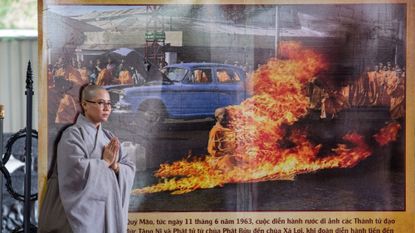A history of self-immolation as 'extreme' act of protest
US airman setting himself on fire in Washington is the latest in long line of shocking such incidents

When US Air Force serviceman Aaron Bushnell set himself on fire outside the Israeli Embassy in Washington last month, he restarted long-standing debates over the impact of self-immolation.
Bushnell, 25, said that he was protesting against "what people have been experiencing in Palestine", and declared he would "no longer be complicit in genocide". He doused himself with flammable liquid and set himself on fire, live-streaming his actions. As he burned, he repeatedly shouted: "Free Palestine!" He died later in hospital from his injuries.
Bushnell's death "prompted news stories, thinkpieces and internal newsroom conversations about how to cover self-immolation", one of the most extreme forms of protest, as well as speculation over his mental health, said The Guardian.
Subscribe to The Week
Escape your echo chamber. Get the facts behind the news, plus analysis from multiple perspectives.

Sign up for The Week's Free Newsletters
From our morning news briefing to a weekly Good News Newsletter, get the best of The Week delivered directly to your inbox.
From our morning news briefing to a weekly Good News Newsletter, get the best of The Week delivered directly to your inbox.
It came three months after an unnamed protester was left in a critical condition after self-immolating outside the Israeli consulate in Atlanta, in what police said was "an act of extreme political protest". A Palestinian flag was found at the scene. But in Bushnell's case, "one thing was clear: it got people talking, in a way that other, multi-person protests have sometimes failed to do", said The Guardian.
What is the history of self-immolation?
The dramatic practice stretches back to antiquity. According to Plutarch's account, an Indian sage and philosopher known as Kalanos travelled with Alexander the Great until 323BC, when the 73-year-old decided that he would rather die than live as an invalid. Despite Alexander's objections, a funeral pyre was eventually constructed by Ptolemy, and Kalanos took his own life.
But its potential for widespread impact is exemplified by Thich Quang Duc, a monk who took his own life in 1963 in protest against the South Vietnamese government's persecution of fellow Buddhists. His self-immolation, in a busy road junction in Saigon, was designed for maximum publicity, with journalists contacted beforehand. It was immortalised in photographs taken by Malcolm Browne of The Associated Press.
Browne's images of the "burning monk" ended up on the front pages of newspapers worldwide. "No news picture in history has generated so much emotion around the world as that one," said the then US President John F Kennedy, as reported by Time.
The international attention intensified pressure on South Vietnam's president Ngo Dinh Diem, and arguably contributed to the US-backed coup that toppled him in 1963. But Quang Duc's death was different because "it inspired many others", wrote Michael Biggs, associate professor of sociology at the University of Oxford, in a 2005 book "Making Sense of Suicide Missions", as it demonstrated two modern innovations.
The availability of flammable liquids like petrol and kerosene made it feasible to burn oneself in public ("without instant ignition, police could thwart any attempt"), while the advent of photography and the ability to quickly disseminate photos "made it possible for a single sacrifice to have a dramatic impact on a huge audience".
After Quang Duc's suicide, there was at least one self-immolation somewhere in the world nearly every year up until 2013, according to Day Blakely Donaldson's 2013 book "The Self-Immolators".
In 2010, Mohamed Bouazizi's suicide in Sidi Bouzid, Tunisia set off a series of protests that eventually led to the Arab Spring. At least 169 Tibetans have self-immolated since 2009, according to the International Campaign for Tibet, many of whom were Buddhist monks and nuns.
What are the wider impacts?
Many who self-immolate declare their intentions, said Biggs, often in written form. In many cases, the decision was "the product of lengthy consideration, as with Quang Duc". But "what is remarkable is the lack of expressions of regret" by survivors, even pride in the "selfless" self-sacrifice as a means to advance the cause.
"It's the most violent nonviolent type of action," Jack Downey, a professor at the University of Rochester, told Time. "They're choosing to end their own life as a public statement. The statement is meant to be shocking, and is meant to articulate their level of grievance."
But some have suggested that the practice is not only ineffectual but also harmful in a wider sense. Such arguments came to the fore due to the politically fraught context of Bushnell's death.
Attention has been drawn to his upbringing in a religious compound in Massachusetts, said The Guardian, and "right-wing, pro-Israel news outlets have suggested, without evidence, that Bushnell may have had mental health issues". That's a common theme, Biggs told the paper.
Many prominent left-wing figures have "weaponised" these concerns by reacting to Bushnell's death in a "shocking and reckless way", said the New York Post. "They're evidently willing to exploit and glorify a suicide", despite the well-known "contagion" effect and potential for copycats, even though the act would have "no actual effect" on the war in Gaza.
Self-immolations also risk movement-wide backlash. Five Falun Gong protesters set themselves on fire in Beijing's Tiananmen Square in 2001, including a 12-year-old girl. They were protesting the Chinese government's suppression of their religion, but "her screams aired on state television for a week", said The Atlantic, "and convinced many otherwise open-minded Chinese that Falun Gong was a death cult whose suppression they should cheer".
"Self-immolation has a tremendous effect in its moment," Indira Palacios-Valladares, a political science professor at Missouri State University, told The Guardian. "It's very dramatic. Death by fire… people don't die immediately. And it's terrible to watch."
Create an account with the same email registered to your subscription to unlock access.
Sign up for Today's Best Articles in your inbox
A free daily email with the biggest news stories of the day – and the best features from TheWeek.com
-
 Mold, bugs at listeria-linked Boar's Head meat plant
Mold, bugs at listeria-linked Boar's Head meat plantSpeed Read Food safety inspectors reported many violations at a Virginia plant that has been linked to a nationwide deli meat recall
By Peter Weber, The Week US Published
-
 'Leaders have dived into the political fray to protect their wealth'
'Leaders have dived into the political fray to protect their wealth'Instant Opinion Opinion, comment and editorials of the day
By Anya Jaremko-Greenwold, The Week US Published
-
 What are the lessons from Ukraine's Russia incursion?
What are the lessons from Ukraine's Russia incursion?Talking Points And what do they mean for Putin's red lines?
By Joel Mathis, The Week US Published
-
 A history of student protest at Columbia University
A history of student protest at Columbia UniversityThe Explainer Anti-Israel demonstrations at NYC's Ivy League university echo protests against Vietnam War and South African apartheid
By Harriet Marsden, The Week UK Published
-
 Germany should have given up a province for the Jewish people
Germany should have given up a province for the Jewish peopleIn Depth The Jews should have been offered a homeland in Franconia, with Jerusalem a place of pilgrimage
By Crispin Black Published